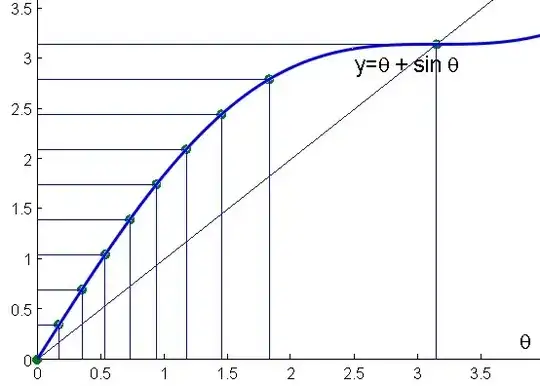

WLOG we can work with the unit circle $S_1$ with point $P(-1,0)$.
The polar equation of $S_1$ with respect to pole $P$ is
$$\tag{1}r=r(\theta)=2 \cos(\tfrac{\theta}{2}), \ \ 0 \leq \theta \leq \pi.$$
Remark: in this way, due to the inscribed angle theorem (see Euclid's proof in (http://aleph0.clarku.edu/~djoyce/java/elements/bookIII/propIII20.html)), $\theta$ can be interpreted as the reference angle with respect to the center $O$ of $S_1$.
The sector area between $\theta_1$ and $\theta_2$ is known to be
$$\tag{2}A_{\theta_1,\theta_2}=\tfrac12 \int_{\theta_1}^{\theta_2}r(\theta)^2d\theta=\int_ {\theta_1}^{\theta_2}2\cos(\tfrac{\theta}{2})^2d\theta =\int_{\theta_1}^{\theta_2}(1+\cos(\theta))d\theta = [\theta+\sin(\theta)]_{\theta_1}^{\theta_2}$$
Let us define function $\varphi$ by
$$\tag{3}\varphi(\theta):=\theta+\sin(\theta).$$
Thus, (2) becomes:
$$\tag{4}A_{\theta_1,\theta_2}=\varphi(\theta_2)-\varphi(\theta_1).$$
$\varphi$ is increasing from $0$ to $2 \pi$ because it has a positive derivative.
It suffices now to subdivide interval $[0,2\pi)$ with values
$$\tag{5}\theta_k:=\varphi^{-1}(\tfrac{2\pi k}{n}).$$
Remark: $\varphi^{-1}$ has no explicit expression (Inverse of $f(x)=\sin(x)+x$), but is connected to a form of Kepler's equation (https://en.wikipedia.org/wiki/Kepler%27s_equation) and to cycloids.
Therefore, we cannot hope to have exact values for the $\theta_k$s. Only a numerical approach is possible. Fotunately, this issue can be solved by the very simple fixed point method. Indeed, as (5) is equivalent to:
$$\tag{6}\theta+\sin(\theta)=\tfrac{2\pi k}{n}$$
itself equivalent to:
$$\tag{7}\theta=A-\sin(\theta), \ \ \ \text{with} \ \ \ A:=\tfrac{2\pi k}{n},$$
the solution $x$ of (7) will be obtained as the limit of the fixed-point iteration sequence :
$$\tag{8}\theta_{i+1}=A-\sin(\theta_i) \ \ \ \text{with} \ \ \ \theta_0=A.$$
(the convergence is granted by the fact that the derivative of the function in the RHS of (8) is $<1$ in open intervals around the roots we are looking for.)

